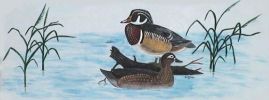Wood Duck House Project: Enhancing Cavity Nesting Waterfowl Success
BPCA members construct and place "wood duck houses" in areas around the Black River delta, maintain the houses, and record breeding success. The project has been very successful: in 2003, BPCA members' houses hatched 704 wood ducks and 1,489 hooded mergansers!

A nice clutch in a BPCA house
History of the Project: The BPCA first sponsored a wood duck house building project in 1971 in coordination with Boy Scout Troop 21 and the Wisconsin Department of Natural Resources. Troop members and club members built 36 houses made of road sign material and placed them in the Lytles and upper Gibbs Lake areas. Most of those houses were destroyed or mutilated by woodpeckers, and the remaining wooden houses have now been removed. In 1978, the club renewed its interest in wood duck nesting structures and purchased 24 Tommy Tubs plastic houses. None of these houses were known to be used by wood ducks, probably because they were very unsteady and unstable with the type of pole mount and the entry hole was too small for some female wood ducks.
Success with Recycled Freon Canisters: Interest in wood duck nesting structures was again renewed in 1987 when several members visited Union Slough National Wildlife Refuge, Titonka Iowa, where we were introduced to the freon canister nesting structures by Glen L. Welp. This kind of nesting structure offered distinct advantages over the previous types. The canister wood duck structures are constructed from discarded 30-pound Freon canisters that normally end up in landfills. Canisters are readily available from local businesses that charge and recharge refrigeration, freezing, and air conditioning equipment. Construction of canister houses is more difficult and time consuming than construction of wooden ones. However, the canister houses are more durable than wooden structures, are rain and weatherproof, are easily removable from pipe mounts for maintenance, and can be easily opened and closed for recording information on nesting and hatching success.


 gmail.com
gmail.com